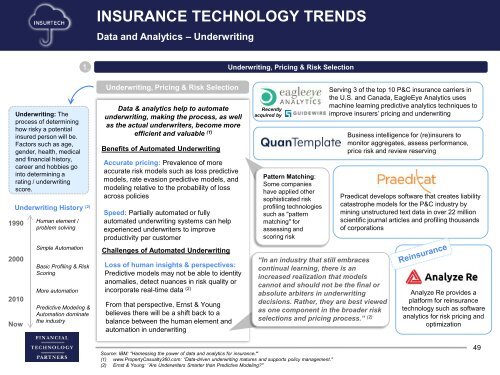Create successful ePaper yourself
Turn your PDF publications into a flip-book with our unique Google optimized e-Paper software.
INSURANCE TECHNOLOGY TRENDS<br />
Data and Analytics – Underwriting<br />
1.<br />
Underwriting, Pricing & Risk Selection<br />
Underwriting: The<br />
process of determining<br />
how risky a potential<br />
insured person will be.<br />
Factors such as age,<br />
gender, health, medical<br />
and financial history,<br />
career and hobbies go<br />
into determining a<br />
rating / underwriting<br />
score.<br />
Underwriting History (2)<br />
1990<br />
2000<br />
2010<br />
Now<br />
Human element /<br />
problem solving<br />
Simple Automation<br />
Basic Profiling & Risk<br />
Scoring<br />
More automation<br />
Predictive Modeling &<br />
Automation dominate<br />
<strong>the</strong> industry<br />
Underwriting, Pricing & Risk Selection<br />
Data & analytics help to automate<br />
underwriting, making <strong>the</strong> process, as well<br />
as <strong>the</strong> actual underwriters, become more<br />
efficient and valuable (1)<br />
Benefits of Automated Underwriting<br />
Accurate pricing: Prevalence of more<br />
accurate risk models such as loss predictive<br />
models, rate evasion predictive models, and<br />
modeling relative to <strong>the</strong> probability of loss<br />
across policies<br />
Speed: Partially automated or fully<br />
automated underwriting systems can help<br />
experienced underwriters to improve<br />
productivity per customer<br />
Challenges of Automated Underwriting<br />
Loss of human insights & perspectives:<br />
Predictive models may not be able to identity<br />
anomalies, detect nuances in risk quality or<br />
incorporate real-time data (2)<br />
From that perspective, Ernst & Young<br />
believes <strong>the</strong>re will be a shift back to a<br />
balance between <strong>the</strong> human element and<br />
automation in underwriting<br />
Recently<br />
acquired by<br />
Pattern Matching:<br />
Some companies<br />
have applied o<strong>the</strong>r<br />
sophisticated risk<br />
profiling technologies<br />
such as "pattern<br />
matching" <strong>for</strong><br />
assessing and<br />
scoring risk<br />
“In an industry that still embraces<br />
continual learning, <strong>the</strong>re is an<br />
increased realization that models<br />
cannot and should not be <strong>the</strong> final or<br />
absolute arbiters in underwriting<br />
decisions. Ra<strong>the</strong>r, <strong>the</strong>y are best viewed<br />
as one component in <strong>the</strong> broader risk<br />
selections and pricing process.” (2)<br />
Serving 3 of <strong>the</strong> top 10 P&C insurance carriers in<br />
<strong>the</strong> U.S. and Canada, EagleEye Analytics uses<br />
machine learning predictive analytics techniques to<br />
improve insurers’ pricing and underwriting<br />
Business intelligence <strong>for</strong> (re)insurers to<br />
monitor aggregates, assess per<strong>for</strong>mance,<br />
price risk and review reserving<br />
Praedicat develops software that creates liability<br />
catastrophe models <strong>for</strong> <strong>the</strong> P&C industry by<br />
mining unstructured text data in over 22 million<br />
scientific journal articles and profiling thousands<br />
of corporations<br />
Analyze Re provides a<br />
plat<strong>for</strong>m <strong>for</strong> reinsurance<br />
technology such as software<br />
analytics <strong>for</strong> risk pricing and<br />
optimization<br />
Source: IBM: “Harnessing <strong>the</strong> power of data and analytics <strong>for</strong> insurance."<br />
(1) www.PropertyCasualty360.com: “Data-driven underwriting matures and supports policy management."<br />
(2) Ernst & Young: ‘’Are Underwriters Smarter than Predictive Modeling?"<br />
49









